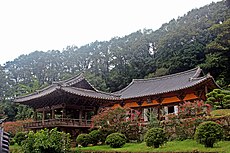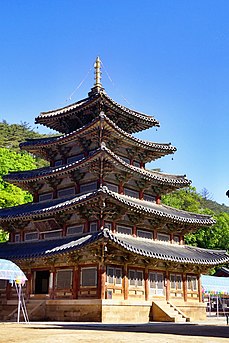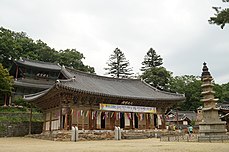| Sansa | |
 | |
| Korean name | |
|---|---|
| Hangul | 산사 |
| Hanja | 山寺 |
| Revised Romanization | Sansa |
| McCune–Reischauer | Sansa |
Sansa (Korean: 산사; lit. mountain temple) is a term for any Korean Buddhist temple located on a mountain. Seven of these temples are designated as UNESCO World Cultural Heritage Sites.[1] With the country being largely mountainous and Buddhism deeply rooted in its history, there are many sansas across the country.
The word sansa is composed of two words, san and sa, which mean mountain and monastery/temple respectively.
UNESCO World Heritage sansas[edit]
| Sansa | Location | Established | |
|---|---|---|---|

|
Tongdosa | Yangsan | 646[2] |

|
Buseoksa | Yeongju | 676[2] |

|
Bongjeongsa | Andong | 677[2] |

|
Beopjusa | Boeun County | Mid 8th Century[2] |

|
Magoksa | Gongju | Latter half of the 9th Century[2] |

|
Seonamsa | Suncheon | Latter half of the 9th Century[2] |

|
Daeheungsa | Haenam County | Latter half of the 9th Century[2] |
See also[edit]
References[edit]
- ^ "Mountain temples join Unesco list : Sansa are at least 1,000 years old and contain unique Korean elements". Korea JoongAng Daily. Retrieved 2021-02-14.
- ^ a b c d e f g "Nomination of Sansa, Buddhist Mountain Monasteries in Korea: For Inscription on the World Heritage List". whc.unesco.org. UNESCO. Retrieved 2021-11-26.
Well, that’s interesting to know that Psilotum nudum are known as whisk ferns. Psilotum nudum is the commoner species of the two. While the P. flaccidum is a rare species and is found in the tropical islands. Both the species are usually epiphytic in habit and grow upon tree ferns. These species may also be terrestrial and grow in humus or in the crevices of the rocks.
View the detailed Guide of Psilotum nudum: Detailed Study Of Psilotum Nudum (Whisk Fern), Classification, Anatomy, Reproduction